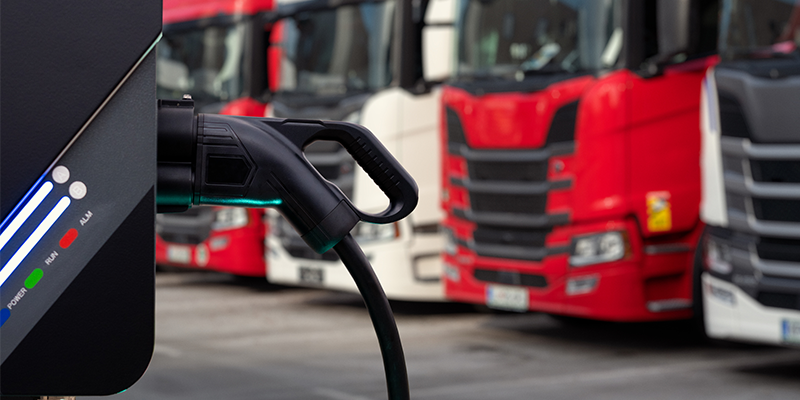California is in a race to implement an ambitious goal: making all new cars and light trucks net zero by 2035. The state has implemented policies pushing fleets to go electric while also providing grants and incentives to help offset costs. On the infrastructure side, there are mandates streamlining the permitting process.
The state’s Advanced Clean Fleets regulation takes effect this year; it requires trucking companies operating in the state to purchase an increasing percentage of zero-emissions trucks in the coming years. So far, enforcement of the regulation has been paused as it hits against the reality of the challenges of meeting this timeline. A complementary initiative, the Advanced Clean Trucks regulation passed in 2023, is designed to phase out sales of medium- and heavy-duty diesel trucks in California by 2036.
“I think this year is going to be a major inflection point,” said Victor Alia, senior development manager at Dedeaux Properties, during a panel discussion at I.CON West in Long Beach, California. “Starting in 2024, no new trucks can be sold that are not EV. We think the need for charging is going to be absolutely crucial, so if you can get ahead of that now, you are in good shape.”
To meet the 2035 requirement by California state law, 53 EV chargers would have to be installed each day, said Lien Dinh, executive vice president of development and construction for Forum Mobility. That number will increase dramatically once older vehicles need to be replaced with zero-emission models.
Annie Otfinoski, founder and CEO of Evest Energy, explained that the current EV vehicles utilize electric battery; hydrogen will be a great alternative but won’t be feasible for another 5-10 years. Battery electric trucks are currently limited to a range of 150-275 miles. There are three different levels of charging infrastructure available, with most tenants looking for fast-charging (50kW-350kW) Level 3 chargers; most chargers are in the 150-to-350kW range right now. There are wide variations in charging times depending on the number and types of batteries in the vehicles, how many vehicles are being charged simultaneously, and other power availability at the site.
Panelists agreed that a depot model, allowing for simultaneous charging of a larger volume of vehicles, including overnight, is the optimal setup for meeting tenant needs, especially with the looming deadlines issued by the state. Tenants know they will need to electrify their fleet eventually, even if they aren’t ready for it just yet.
“The depot model will help with the acceleration to the transition to zero emission because it can serve more tenants,” said Dinh. “It can be viewed as a tenant amenity.”
“The depot model is essentially build-to-suit,” said John Gaglio, president, Newport Utility Consulting. “The utility loves to see that because the load is known up front… By going to them with a known load and a known depot site, the utility really can come to the table and help you work to service that site.”
“The challenge is diversity of the load,” said Gaglio. In utility infrastructure, just because you’re putting in a 4,000-amp service doesn’t mean you will use that much at any one time – the demand load. For comparison, Alia noted that a 4,000-amp board is equivalent to the power used in 275 homes, assuming a 50% demand factor (50% of the power in a home is running at any time).
The power company doesn’t always have enough data to understand how much power will be used for EV charging and how much for the building. It helps to approach the utility with a non-speculative load, Giglio added; if a company submits a speculative load to Southern California Edison, they may not get that amount reserved because the utility is not sure if the full amount will actually be used.
“It definitely helps the case to do build-to-suit instead of speculative… especially if the tenant is going to electrify any amount of their fleet,” said Alia. This is a good time to make use of California’s grants and incentives, Otfinoski said, including the Investment Tax Credit, which is also transferable; low carbon fuel tax credits; and the $183 million EnergIIZE Grant, to help offset the expenses involved with implementing EV infrastructure. There is $50 million available today.
“It pays to start that [EV infrastructure] conversation early when you’re looking at the project,” said Alia. “We can do a power feasibility study with Edison to see how much power is in the area and what the cost would be to bring more power to the area. Take advantage of as many grants and incentives as possible.”
“There is no holistic approach,” Gaglio said. “Over the next 10-15 years, this will be solved site by site, project by project.” He recommended approaching the utility in three phases, with the number of chargers needed in each phase. “You tend to get better feedback on your study, and it can show how the load will impact the utility system… You’re not going to get better results if you ask for 20 megawatts when you only need 10 megawatts; they will just tell you they can’t serve that load.”
“This is definitely the best time to start looking at capitalizing on these grants and incentives,” Otfinoski said. “In 5 years, there will be greater urgency and need, but less capital available to invest in it.”

This post is brought to you by JLL, the social media and conference blog sponsor of NAIOP’s I.CON West 2024. Learn more about JLL at www.us.jll.com or www.jll.ca.













